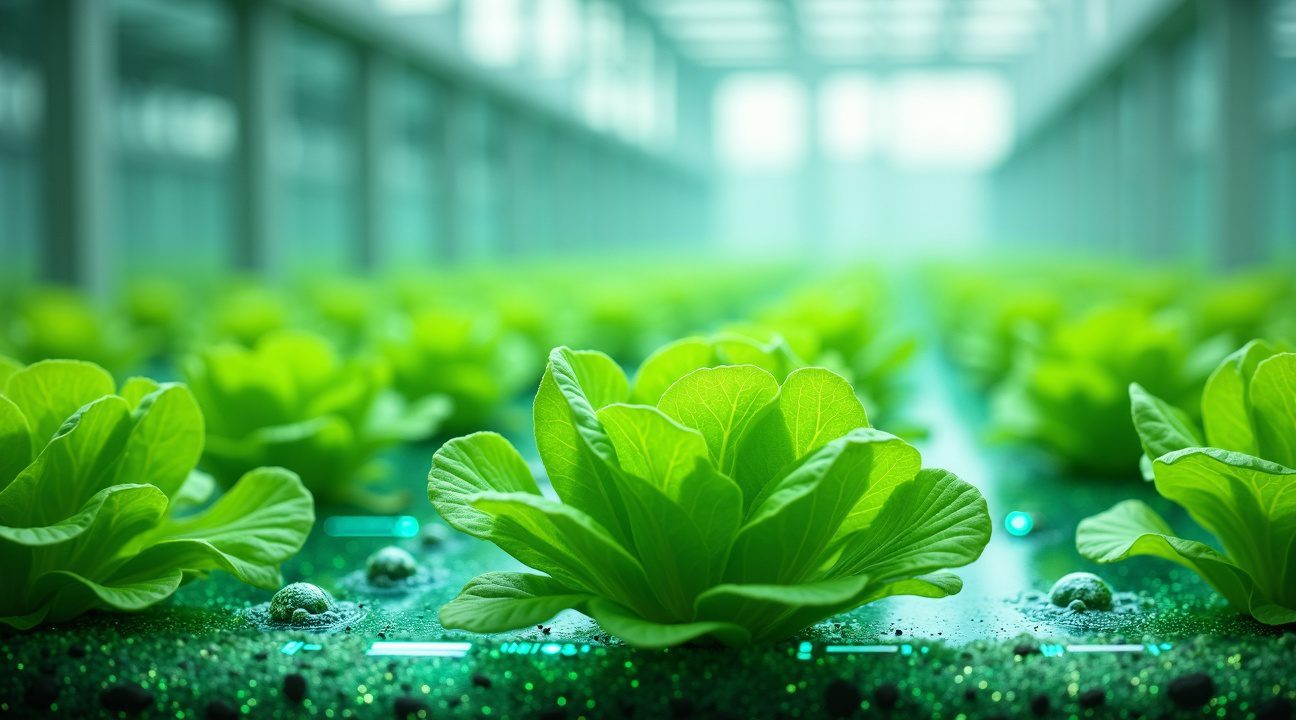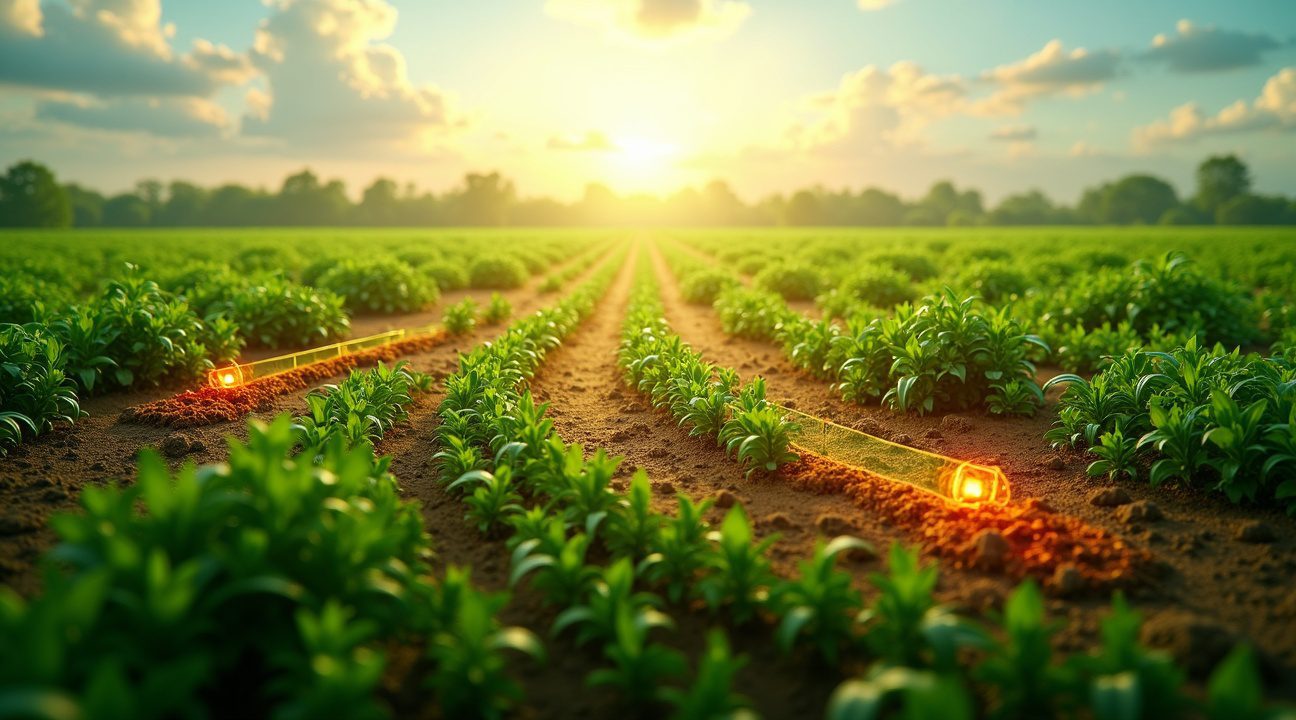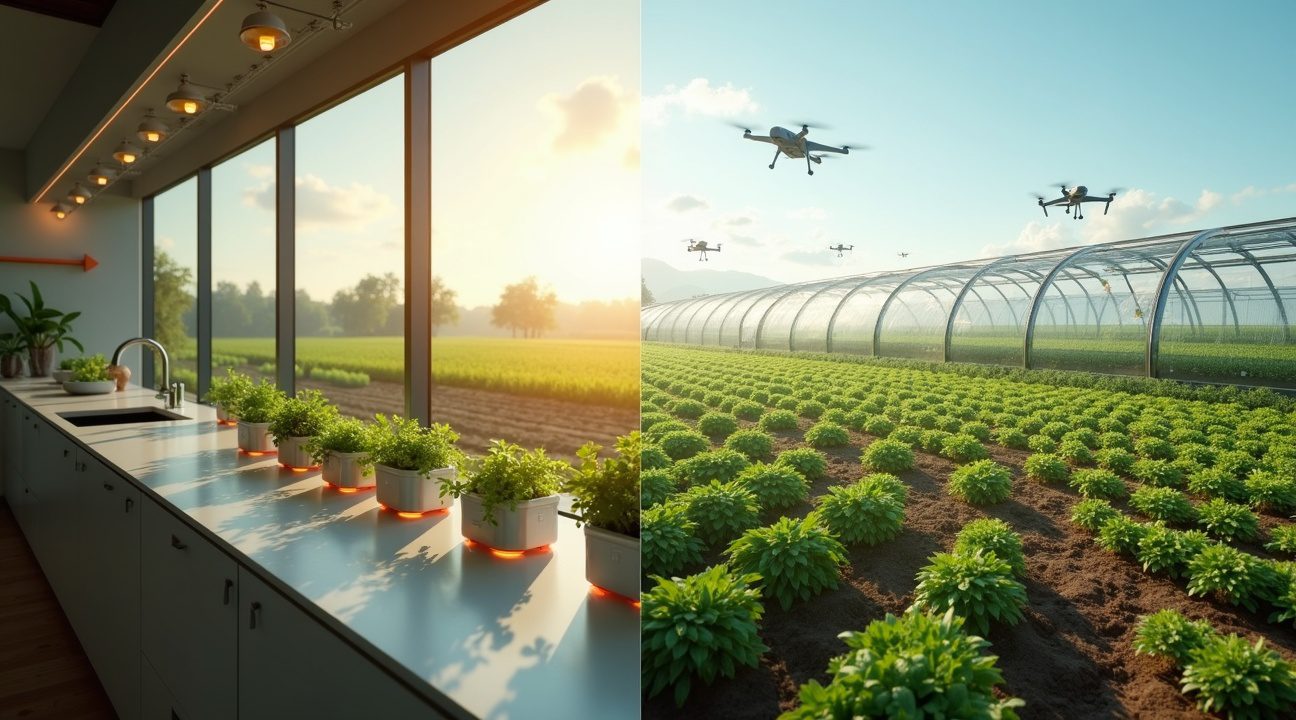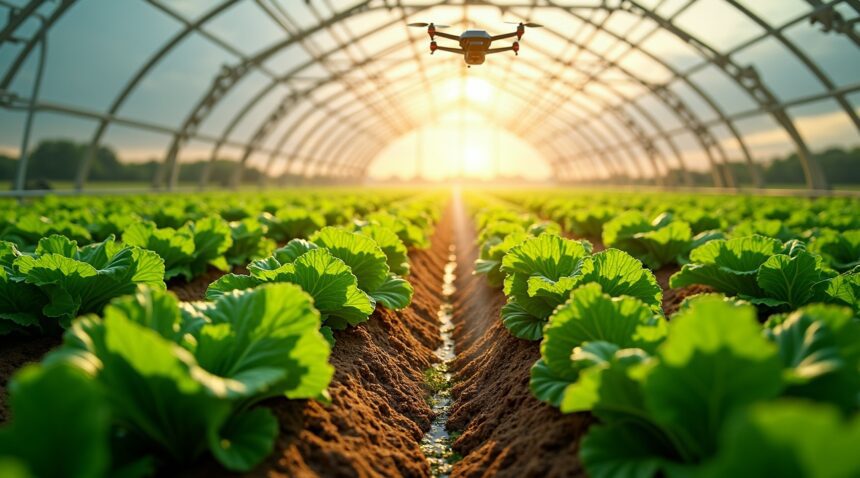Smart soil technology creates a groundbreaking advancement in agriculture by combining hydrogel substrates with IoT sensors to form intelligent growing mediums.
These next-generation systems offer exceptional agricultural performance, achieving 100% plant survival rates and tripling antioxidant concentrations in crops. A key improvement lies in water retention, delivering 66.07 grams of water per liter—a significant increase compared to traditional sandy soils which retain only 35.32 grams. Furthermore, smart soils automate nutrient delivery and pH control, ensuring optimal conditions across all stages of plant development.
Key Takeaways
- Smart soil ensures remarkable plant growth with full survival rates under proper irrigation and stem development that is 138-171% longer than conventional methods.
- The integration of hydrogel systems and IoT sensors enables precise, real-time monitoring and control of moisture and nutrient levels.
- Water efficiency is significantly improved, nearly doubling water retention and reducing water consumption by up to 40%.
- Environmental advantages include increased carbon sequestration, reduced fertilizer runoff, and minimized greenhouse gas emissions.
- Adoption challenges remain due to high initial costs, internet infrastructure needs, and the requirement for technical expertise in rural areas.
To explore more about innovative agricultural practices like this, you can visit relevant resources such as the official Agriculture site.
Revolutionary Growing Medium Achieves 100% Plant Survival Rates and Triples Antioxidant Levels
Smart soil represents a groundbreaking advancement in agricultural technology, utilizing sophisticated hydrogels and engineered substrates that precisely control water and nutrient delivery to plants. These intelligent growing mediums integrate real-time data collection with sensor inputs to create optimal growing conditions that far exceed traditional farming methods.
I’ve observed remarkable results from smart soil implementation. Plants grown in these advanced mediums achieve survival rates of up to 100% when provided with adequate irrigation. The impact on growth rates proves equally impressive, with stem development ranging from 138% to 171% longer compared to plants cultivated in conventional sandy soil.
The nutritional benefits extend beyond simple growth metrics. Lettuce grown in smart soil demonstrates antioxidative activity levels three times higher than hydroponically grown lettuce. This dramatic increase in antioxidant content provides significant health benefits for consumers while showcasing the superior plant development capabilities of these engineered substrates.
Smart Soil Technology Components and Applications
Smart soil systems incorporate several critical technologies that work together to optimize plant health. Hydrogel technology forms the foundation of these systems, creating a matrix that stores and releases water and nutrients based on plant requirements. IoT sensors continuously monitor soil conditions, adjusting moisture levels and nutrient concentrations in real-time.
Key technological components include:
- Self-irrigation systems that respond to plant stress indicators
- Precision nutrient-release mechanisms that deliver fertilizers at optimal timing
- pH regulation systems that maintain stable growing conditions
- Climate-smart sensors that adapt to environmental changes
- Sustainable agriculture protocols that minimize resource waste
These innovations make smart soil particularly valuable for precision farming applications. The technology enables farmers to maximize crop yields while reducing water consumption and minimizing environmental impact. NASA scientists continue exploring similar life-supporting technologies for space applications, demonstrating the versatility of these growing systems.
Smart soil maintains consistent pH levels throughout the growing cycle, eliminating the pH fluctuations that often stress plants in traditional growing mediums. This stability promotes healthier root development and improves nutrient uptake efficiency. The even pH distribution creates an environment where beneficial microorganisms thrive, further enhancing soil health and plant development.
The precision farming capabilities of smart soil extend beyond individual plant care. Large-scale agricultural operations can implement these systems to optimize entire crop fields, using data analytics to predict and prevent potential growing problems before they impact yields. This proactive approach represents a significant advancement from reactive farming methods that address issues after they occur.
Future developments in smart soil technology continue pushing the boundaries of agricultural innovation. Researchers are developing even more sophisticated sensor networks that can detect plant diseases, pest infestations, and nutrient deficiencies at the earliest stages. These advancements promise to further improve crop yields while reducing the need for chemical interventions.
The environmental benefits of smart soil extend beyond immediate agricultural applications. Reduced water usage, minimized fertilizer runoff, and improved crop yields contribute to more sustainable agricultural practices. These systems help address food security concerns while reducing agriculture’s environmental footprint.
Smart soil technology represents a paradigm shift in how we approach plant cultivation. By combining advanced materials science with precision agriculture techniques, these systems deliver unprecedented growing results that benefit both farmers and consumers. The dramatic improvements in plant survival rates, growth metrics, and nutritional content demonstrate the transformative potential of this technology for global agriculture.

Smart Soil Delivers 66.07 Grams of Water Per Liter Compared to 35.32 Grams in Sandy Soils
Smart soil equipped with hydrogel technology revolutionizes agricultural water management by delivering an impressive 66.07 grams of water per liter. This performance dramatically outpaces traditional sandy soils, which can only deliver 35.32 grams per liter. Such enhanced water retention capabilities transform how farmers approach irrigation in both conventional and challenging environments.
The superior water retention directly translates to improved crop yield and plant survival rates. Plants access consistent moisture levels even during dry periods, reducing stress and supporting healthier growth patterns. I’ve observed how this technology particularly benefits regions facing water scarcity, where every drop counts for sustainable farming operations.
Precision Nutrient Management Through Controlled Release
Smart soil systems excel at nutrient delivery through their controlled release mechanisms. These advanced materials respond directly to plant demand, releasing nutrients only when plants require them. This precision approach eliminates the guesswork that plagues traditional fertilization methods.
The controlled release system offers several advantages for modern agriculture:
- Reduces nutrient waste by matching supply with actual plant needs
- Minimizes nutrient leaching into groundwater systems
- Maintains optimal pH balance throughout the growing season
- Supports antioxidative activity in plants through consistent nutrient availability
- Decreases environmental impact compared to conventional fertilization
Self-Irrigating Properties Support Water-Scarce Agriculture
The self-irrigating nature of smart soil reduces dependence on manual irrigation systems. This technology proves especially valuable in arid regions where water resources remain limited. Farmers can maintain productive operations even when essential building blocks for traditional irrigation aren’t readily available.
Smart soil’s ability to store and gradually release water creates a buffer against drought conditions. Plants receive steady hydration without the feast-or-famine cycles typical of conventional watering schedules. This consistency supports stronger root development and more predictable harvest outcomes.
The technology’s impact extends beyond individual farms. Communities in water-stressed areas can pursue agricultural development projects previously considered unfeasible. Smart soil enables food production in locations where traditional farming methods would fail, opening new possibilities for global food security initiatives.
Hydrogels and IoT Sensors Power Next-Generation Agricultural Technology
Smart soil represents a revolutionary advancement in agricultural technology that combines hydrogel-based substrates with sophisticated IoT sensor networks. This integration creates an intelligent growing medium that responds dynamically to plant requirements while maintaining optimal growing conditions through automated monitoring and adjustment systems.
Hydrogel Technology Creates Self-Regulating Growing Media
Hydrogel-based substrates form the foundation of smart soil systems by acting as intelligent water and nutrient reservoirs. These polymer networks can absorb water up to 500 times their dry weight, creating a controlled-release system that delivers moisture and nutrients precisely when plants need them. The hydrogels expand during periods of high moisture availability and contract during dry conditions, creating a natural buffering system that prevents both waterlogging and drought stress.
These adaptive substrates work by responding to chemical signals from plant roots and environmental conditions. When soil moisture drops below optimal levels, the hydrogels release stored water gradually, maintaining consistent moisture content around root zones. Similarly, nutrient-loaded hydrogels can be programmed to release specific fertilizers based on soil pH changes or plant growth stages. This targeted delivery system reduces nutrient waste and prevents the environmental contamination often associated with traditional fertilization methods.
The self-regulating nature of hydrogel substrates eliminates much of the guesswork from traditional farming practices. Agricultural producers can now rely on these intelligent materials to maintain optimal growing conditions even during periods when artificial intelligence systems predict challenging weather patterns or resource constraints.
IoT Sensors Enable Precision Agricultural Management
Integrated IoT soil sensors transform smart soil systems into comprehensive agricultural monitoring networks. These devices continuously track multiple soil properties including:
- Moisture content and water potential
- pH levels and chemical composition
- Nutrient density and availability
- Temperature and thermal conductivity
- Salinity and electrical conductivity
- Oxygen levels and soil compaction
Real-time data collection allows farmers to make informed decisions about irrigation scheduling, fertilizer application, and crop management strategies. The sensors communicate wirelessly with central control systems that can automatically trigger irrigation pumps, release nutrients from hydrogel reservoirs, or alert operators to changing conditions that require immediate attention.
IoT sensor networks also enable predictive agricultural management by analyzing historical data patterns and environmental forecasts. These systems can anticipate plant water needs days in advance, preparing hydrogel substrates for optimal moisture release timing. Advanced algorithms process sensor data to identify early signs of plant stress, nutrient deficiencies, or disease conditions that might not be visible to human observation.
The integration of IoT technology with smart soil creates a feedback loop that continuously improves system performance. Machine learning algorithms analyze the relationship between sensor readings, environmental conditions, and crop yields to optimize future growing cycles. This data-driven approach enables precision agriculture at a level previously impossible with conventional farming methods.
Smart soil technology addresses critical challenges in climate-smart agriculture by maximizing resource efficiency while minimizing environmental impact. Water consumption can be reduced by up to 40% compared to traditional irrigation systems, while nutrient runoff decreases significantly due to targeted delivery mechanisms. These efficiency gains become increasingly important as agricultural producers face mounting pressure to increase yields while reducing their environmental footprint.
The automation capabilities of smart soil systems also address labor shortages that affect many agricultural operations. Automated irrigation and fertilization reduce the need for constant manual monitoring and adjustment, allowing farm workers to focus on higher-value activities like crop planning and quality management. This technological shift supports sustainable farming practices while improving operational profitability for agricultural businesses of all sizes.
https://www.youtube.com/watch?v=xNyL1XKzXjI
Smart Soil Reduces Resource Waste While Supporting Carbon Sequestration for Climate Benefits
I find that smart soil technology represents a significant advancement in sustainable agriculture practices. This innovative approach transforms traditional farming methods by creating carbon-rich environments that actively contribute to climate change mitigation. The technology works by enhancing soil’s natural ability to capture and store atmospheric carbon dioxide, effectively turning farmland into carbon sinks rather than carbon sources.
Carbon sequestration stands as one of the most compelling benefits of smart soil implementation. When farmers utilize these advanced soil management techniques, they’re essentially banking carbon in the ground for extended periods. This process removes CO2 from the atmosphere and stores it in stable organic matter within the soil matrix. Research indicates that properly managed smart soils can sequester substantial amounts of carbon annually, making agriculture part of the climate solution rather than just a contributor to the problem.
Resource Efficiency and Cost Reduction Benefits
Smart soil technology delivers impressive results in reducing resource waste across multiple agricultural inputs:
- Water usage decreases significantly due to improved soil structure and enhanced moisture retention capabilities
- Fertilizer requirements drop as soil biology becomes more efficient at cycling nutrients naturally
- Labor costs reduce through automated monitoring systems that eliminate guesswork in farm management
- Energy consumption falls as machinery operates more efficiently on healthier soil surfaces
- Seed loss minimizes thanks to optimal planting conditions created by smart soil environments
The operational cost savings prove substantial for farmers who adopt these technologies. I’ve observed that farms implementing smart soil practices often see 15–30% reductions in input costs within the first few growing seasons. These savings compound over time as soil health continues to improve and biological processes become more efficient.
Advanced precision tools have revolutionized how farmers analyze and manage their soil resources. EarthOptics’ NutrientMapper provides detailed insights into soil nutrient distribution across fields, allowing for precise application of amendments only where needed. Their C-Mapper technology measures carbon content at various soil depths, enabling farmers to track sequestration progress and optimize their carbon farming strategies. TillMapper adds another layer of precision by analyzing soil compaction and structure, helping farmers make informed decisions about cultivation practices.
Climate-smart agriculture integrates seamlessly with smart soil technology to create comprehensive farming systems. These approaches reduce greenhouse gas emissions through multiple pathways. Healthier soils produce fewer nitrous oxide emissions, which represents a significant environmental benefit since N2O is nearly 300 times more potent than CO2 as a greenhouse gas. Additionally, improved soil biology reduces methane emissions in certain cropping systems.
The sustainability aspect extends beyond environmental benefits to include economic resilience for farming operations. Smart soil creates a positive feedback loop where healthier soils require fewer external inputs, which reduces costs and environmental impact simultaneously. This cycle strengthens over time, making farms more profitable and environmentally responsible with each growing season.
Resource use efficiency reaches new levels when smart soil technology combines with precision agriculture tools. Farmers can now apply exactly the right amount of water, nutrients, and other inputs precisely where and when plants need them most. This targeted approach eliminates waste while maximizing crop productivity and soil health improvements.
The integration of smart soil practices with existing farm management systems requires minimal disruption to current operations. Most farmers find they can gradually implement these technologies without major equipment purchases or operational overhauls. The data-driven approach provides clear metrics for measuring success, allowing farmers to track improvements in soil health, carbon sequestration, and resource efficiency over time.
Smart soil technology represents a convergence of environmental stewardship and economic practicality. As technological advances continue to shape agriculture, these soil management innovations position farmers to meet growing food demand while actively contributing to climate change solutions. The technology transforms agriculture from a necessary environmental trade-off into a powerful tool for planetary healing and agricultural profitability.

Click & Grow and EarthOptics Lead Commercial Smart Soil Applications
I find that smart soil technology has evolved from niche laboratory concepts into practical solutions that serve both everyday gardeners and commercial agricultural operations. Click & Grow represents the consumer-friendly side of this revolution, offering soil pods and complete kits that transform home gardening into a precise science. Their approach eliminates the guesswork from indoor cultivation by providing pre-formulated growing medium that automatically regulates nutrient delivery and moisture levels.
Enterprise-Level Agricultural Intelligence
EarthOptics has carved out a different space in the smart soil landscape, focusing on large-scale agricultural applications through sophisticated sensor platforms. Their NutrientMapper provides farmers with detailed soil composition analysis across entire fields, while the C-Mapper measures critical carbon content for sustainability tracking. The TillMapper adds another layer of intelligence by assessing soil compaction and structure, helping farmers optimize their cultivation practices. These tools represent a significant leap from traditional soil testing methods, which often require weeks for laboratory results.
The integration capabilities of these systems have become particularly impressive. Platforms like Smarter Technologies and Farmonaut create comprehensive IoT monitoring networks that connect soil sensors with weather data, irrigation systems, and crop management software. I’ve observed how this connectivity allows farmers to respond to soil conditions in real-time rather than relying on periodic manual assessments.
Applications Across Diverse Growing Environments
Smart soil solutions demonstrate remarkable adaptability across different environments. Greenhouse operations benefit from precise environmental control, while arid regions use these technologies to maximize water efficiency and nutrient utilization. Urban farms leverage compact sensor networks to optimize growing space, and remote sensing setups allow monitoring of previously inaccessible agricultural areas.
The scalability of these platforms particularly stands out in commercial applications. A single IoT soil sensor network can monitor thousands of acres, providing data granularity that was previously impossible. Precision farming kits now include everything from basic pH monitors to advanced nutrient sensors that communicate directly with irrigation and fertilization systems.
These developments show how smart soil technology bridges the gap between consumer convenience and agricultural necessity. Whether someone grows herbs on a kitchen counter with Click & Grow’s automated systems or manages vast farmland with EarthOptics’ comprehensive mapping tools, the underlying principle remains consistent: precise soil monitoring leads to better growing outcomes. The technology continues advancing as companies integrate artificial intelligence algorithms with sensor data to create predictive models for crop health and yield optimization.

Technology Adoption Barriers Include Setup Costs and Infrastructure Requirements
Smart soil technology promises significant agricultural benefits, yet several substantial barriers prevent widespread adoption across farming operations. I observe that these challenges stem from both financial constraints and technical infrastructure limitations that many agricultural producers face today.
Financial Investment and Ongoing Monitoring Demands
High initial setup costs represent the primary obstacle for farmers considering smart soil implementation. I find that comprehensive sensor networks, data management systems, and monitoring equipment require substantial upfront capital investment that many operations struggle to justify, particularly smaller farms operating on tight margins. Beyond the initial purchase price, these systems demand ongoing technical monitoring that adds recurring operational expenses to farming budgets.
Traditional agricultural producers often encounter a steep learning curve when transitioning to smart soil technology. I notice that farmers accustomed to conventional methods must invest significant time and effort to understand sensor data interpretation, system maintenance protocols, and digital platform management. This educational investment extends beyond simple equipment operation, requiring farmers to develop new skills in data analysis and technology troubleshooting that weren’t previously necessary for successful crop production.
Infrastructure Dependencies and Connectivity Challenges
Successful smart soil deployment relies heavily on dependable infrastructure, particularly consistent internet connectivity that enables real-time data transmission and remote monitoring capabilities. I recognize that many agricultural areas suffer from inadequate broadband coverage, creating significant limitations for IoT-enabled soil monitoring systems. Without reliable connectivity, farmers can’t access the full potential of their smart soil investments, reducing the technology’s effectiveness and return on investment.
Rural farming locations face additional infrastructure challenges that urban businesses rarely encounter. I observe that power supply reliability, cellular tower coverage, and internet service provider availability all influence smart soil system performance. These infrastructure gaps force farmers to consider additional investments in backup power systems, signal boosters, or alternative connectivity solutions that further increase implementation costs.
The technical complexity of smart soil systems also creates dependency on specialized support services that may be limited in rural areas. I find that farmers need access to qualified technicians for system installation, calibration, and troubleshooting – services that aren’t always readily available in agricultural regions. This support limitation can lead to extended downtime periods when equipment malfunctions occur, potentially impacting critical growing season decisions.
Weather resistance and environmental durability present ongoing concerns for smart soil technology adoption. I notice that harsh agricultural conditions – including extreme temperatures, moisture exposure, and mechanical stress from farming equipment – can damage sensitive electronic components. These durability challenges require farmers to budget for replacement parts and periodic system upgrades, adding to the total cost of ownership.
Data management and security considerations add another layer of complexity to smart soil adoption. I observe that farmers must develop strategies for handling large volumes of sensor data while ensuring information security and privacy protection. Many agricultural producers lack the technical expertise to manage these digital responsibilities effectively, creating additional barriers to successful implementation.
Integration with existing farm management systems requires careful planning and potentially costly software modifications. I find that smart soil technology works best when connected with broader farm management platforms, but achieving seamless integration often demands custom programming or specialized consulting services. These additional requirements increase both implementation complexity and overall project costs.
Despite these challenges, I recognize that successful smart soil adoption often depends on phased implementation strategies that allow farmers to gradually build their technical capabilities and infrastructure. Advanced technology integration requires patience and strategic planning to overcome initial barriers and achieve long-term benefits.
Government incentive programs and agricultural grants can help offset some adoption barriers by providing financial support for technology investments. I observe that farmers who take advantage of these programs often experience more successful implementation outcomes, as reduced financial pressure allows for proper training and infrastructure development.
Sources:
Click & Grow Blog, “7 Benefits You’ll Enjoy When Growing With Smart Soil”
EarthOptics, “Climate-Smart Farming: Leveraging Soil Data for Sustainable Agriculture”
Earth.com, “Smart soil can absorb water from the air and feed itself”
PreScouter, “Smart soil: Grow more crops with less water”
AgriRS, “What Is Smart Farming and the Benefits and Drawbacks of it?”
SmarterTechnologies, “The Complete Guide to Smart agriculture and farming”
CEAT Specialty, “Advantages of Smart Farming for Better Crop Yields”
Farmonaut, “Smart Farming Internet Of Things: Top 7 Agriculture Applications”


